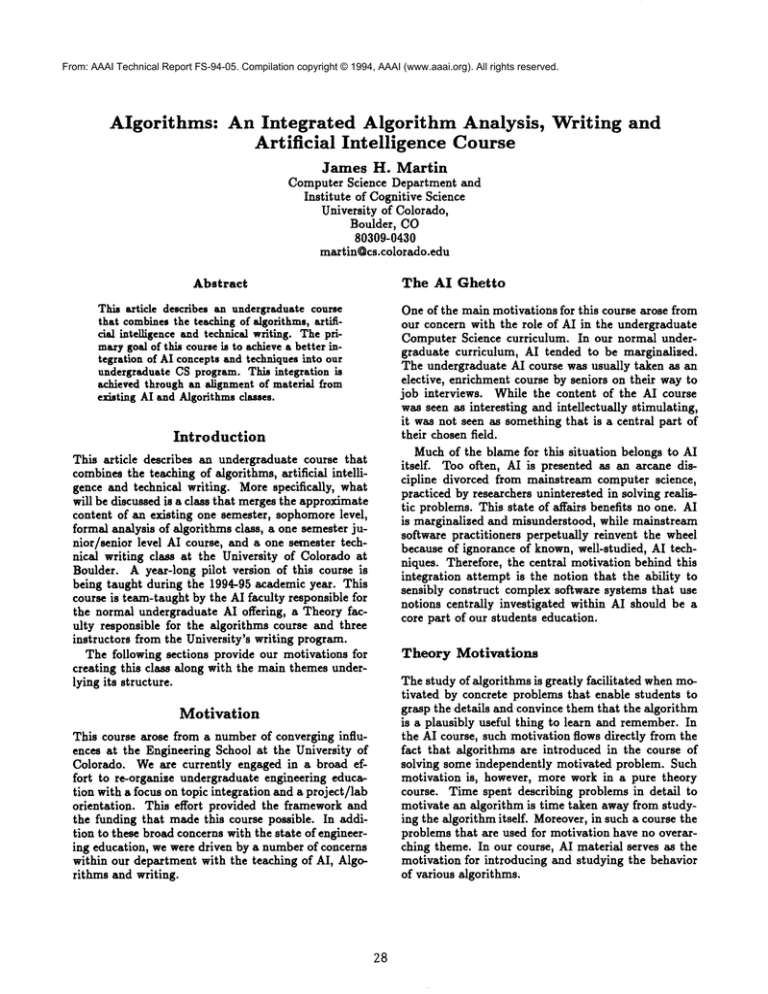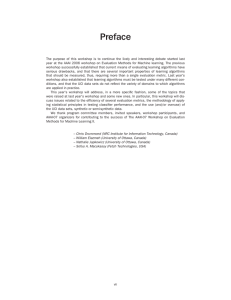
From: AAAI Technical Report FS-94-05. Compilation copyright © 1994, AAAI (www.aaai.org). All rights reserved.
AIgorithms:
An Integrated
Artificial
Algorithm
Intelligence
Analysis,
Course
Writing
and
James H. Martin
Computer Science Department and
Institute of Cognitive Science
University of Colorado,
Boulder, CO
80309-0430
martin@cs.colorado.edu
Abstract
The AI Ghetto
This article describes an undergraduate course
that combinesthe teaching of algorithms, artiticial intelligence and technical writing. The primarygoal of this course is to achieve a better integration of AI concepts and techniques into our
undergraduate CS program. This integration is
achieved through an alignment of material from
existing AI and Algorithmscluses.
Introduction
This article describes an undergraduate course that
combinesthe teaching of algorithms, artificial intelligence and technical writing. More specifically,
what
will be discussed is a class that merges the approximate
content of an existing one semester, sophomorelevel,
formal analysis of algorithms class, a one semester junior/senior level AI course, and a one semester technical writing class at the University of Colorado at
Boulder. A year-long pilot version of this course is
being taught during the 1994-95 academic year. This
course is team-taught by the AI faculty responsible for
the normal undergraduate AI offering, a Theory faculty responsible for the algorithms course and three
instructors from the University’s writing program.
The following sections provide our motivations for
creating this class along with the main themes underlying its structure.
Motivation
This course arose from a number of converging influences at the Engineering School at the University of
Colorado. We are currently engaged in a broad effort to re-organize undergraduate engineering education with a focus on topic integration and a project/lab
orientation. This effort provided the framework and
the funding that made this course possible. In addition to these broad concerns with the state of engineering education, we were driven by a number of concerns
within our department with the teaching of AI, Algorithms and writing.
28
One of the main motivations for this course arose from
our concern with the role of AI in the undergraduate
Computer Science curriculum. In our normal undergraduate curriculum, AI tended to be marginalized.
The undergraduate AI course was usually taken as an
elective, enrichment course by seniors on their way to
job interviews. While the content of the AI course
was seen as interesting and intellectually stimulating,
it was not seen as something that is a central part of
their chosenfield.
Muchof the blame for this situation belongs to AI
itself. Too often, AI is presented as an arcane discipline divorced from mainstream computer science,
practiced by researchers uninterested in solving realistic problems. This state of affairs benefits no one. AI
is marginalized and misunderstood, while mainstream
software practitioners perpetually reinvent the wheel
because of ignorance of known, well-studied, AI techniques. Therefore, the central motivation behind this
integration attempt is the notion that the ability to
sensibly construct complex software systems that use
notions centrally investigated within AI should be a
core part of our students education.
Theory
Motivations
The study of algorithms is greatly facilitated when motivated by concrete problems that enable students to
grasp the details and convince them that the algorithm
is a plausibly useful thing to learn and remember. In
the AI course, such motivation flows directly from the
fact that algorithms are introduced in the course of
solving some independently motivated problem. Such
motivation is, however, more work in a pure theory
course. Time spent describing problems in detail to
motivate an algorithm is time taken away from studying the algorithm itself. Moreover,in such a course the
problems that are used for motivation have no overarching theme. In our course, AI material serves as the
motivation for introducing and studying the behavior
of various algorithms.
AI Content
Problem Solving using State Space Search
Logic and Theorem Proving
Natural Language Processing
Robot Motion Planning
Reasoning with Uncertainty
Algorithm Content
Graph Search and Optimization
Computational Complexity and NP Completeness
Parsing Theory and Dynamic Programming
Computational Geometry
Probability Theory and Randomized Algorithms
Table 1: Aligned AI and Algorithm Material
Writing Motivations
The writing ability of our undergraduates has been a
source of unending frustration to the faculty. The existing writing course requirements were clearly not doing an adequate job. What was needed was a way
to integrate writing directly into the CS curriculum
rather than teaching it as a separate skill. However,
few faculty were willing to take on the additional burden of critiquing and grading a large number of written assignments. The solution taken in this course was
to integrate the same resources that would have been
used to teach separate writing classes directly into our
course. Three technically informed instructors from
the writing program were therefore assigned as addition instructors in our course.
Course
Themes
Content Integration
At the core of this course is an alignment of material
from our Algorithms and AI courses. This alignment
is designed in such a way that specific algorithms and
their related complexity issues arise in the course of
solving specific AI motivated problems. Table 1 shows
some of this proposed alignment. It should be noted
that the entire course content does not fit neatly into
our current scheme; where necessary, material is presented that is pertinent to one area alone.
Weare using two rather voluminous texts to support
the course: Cormen, Leiserson and Rivest’s Introduction to Algorithms (1991) supports the theory material
while Russell and Norvig’s Introduction to Artificial Intelligence (1994) used for the AI content.
The following two sections present more detailed examples from two parts of the current offering. Note
that these two topics were deliberately chosen because
of the natural degree of overlap.
Search
The AI domain of problem solving through state-space
search had a high degree of overlap with the existing
algorithms class. Amongsome of the basic algorithms
and data-structures that were identical in both of our
existing classes were depth-first, breadth-first and uniform cost search, along with a variety of issues involving dynamic programmingapproaches to saving partial
solutions. In our AI course these topics are illustrated
29
using a variety of problem solving domains including
but not limited to route-planning and game playing.
In addition to the above topics, this part of the class
also introduces algorithms that are not typically part
of an algorithm class. Algorithms such as depth-first
iterative deepening, beamsearch, best-first search, A*,
IDA*and simulated annealing are all algorithms wellstudied in AI that seek to overcomethe practical limitations of more well-knowntheoretical algorithms.
Parsing
A central part of modern natural language processing involves the declarative representation of grammatical constraints and the development of algorithms
to parse and generate strings (sentences) using those
constraints. These same topics have, of course, also
been of central concern in the area of programming
languages and compilers.
This section of the course will be organized around
a project such as a natural language consultant system
to provide advice on sometopic. Wewill cover various
parsing and semantic translation techniques to support
this project. Amongthe topics that will be covered are
the CYKand Earley parsing, LR parsing, and Prolog
style DCGbased parsing.
Project
Orientation
It is becomingincreasingly clear that students are learn
and retain more material when they are involved in a
ongoing project to build something useful. Although
it wouldappear that AI courses have the requisite features for a project orientation, they are rarely structured this way. Rather, they usually consist of a series
of toy homeworkassignments none of which are very
convincing. One reason for this is time. It is very difficult to do significant projects in a one-semester course
and still cover the required breadth of material. Our
course is oriented around a small number of projects
over the course of the year.
Our projects are, by design, vaguely defined and essentially open-ended in scope. The intent is to force
students to identify tractable subproblems and choose
appropriate mechanisms based on what they’ve learned
in the class. In the approach we are pursuing there is
no one-to-one mapping between the "the technique we
learned this week" to this week’s homework. Rather,
students must learn to apply appropriate techniques to
the problems that they themselves have chosen. The
following are amongthe projects we are presenting to
students this semester.
¯ Design a kiosk-based tourist advisor system. The
system should present information about tourist attractions based on stated user preferences.
¯ Design a system to perform route planning within
Boulder.
¯ Design a system to optimize traffic flow based on
placement of traffic lights in a simulated mapof the
city.
In addition to skeletal project descriptions given at
the beginning of the year, students are provided with
more detailed constraints during the course of the year
to motivate class content. For example, after having covered basic graph search algorithms, students
are successively told to modify their systems to prefer right turns in route-planning, then prefer turning
left at intersections with left-turn arrows and then to
prefer traveling on roads with timed-lights in the correct direction of travel.
Communication
As noted above, the teaching of writing is also integrated into this class. Three instructors from the University Writing Program teach smaller sections that
complement the main course. The focus in these sections is twofold: communicating their ideas to their
technical peers and communicating to a non-technical
audience. The projects provide the fodder for this
section of the course and the students must prepare
written project reports detailing their results. These
reports form the basis for their course grades. Under our current scheme, the writing instructors review
these reports for writing and organizational structure
while the main course instructors assign grades for the
actual analysis and implementation.
Advanced Topics
An anticipated effect of this class is that students will
be exposed to basic AI content much earlier in their
undergraduate program. This fits in well with other
developments in our curriculum. We have been and
will continue to offer an increasing numberof advanced
AI-related undergraduate classes. Our undergraduate
Natural Language Processing and undergraduate Connectionism classes are nowtwo fixtures in our program.
A significant difficulty we have had in the past is that
most of our majors wait until their senior year to take
the introductory AI class which is a prerequisite to
these advanced classes. Under our new course revision
these students will have received adequate preparation
for advancedclasses before their senior year.
Summary
The central motivation for this course is the notion
that our students should view topics that are centrally
3O
investigated under the AI umbrella as being a central
part of their major field. No isolated course taken during their senior year and divorced from the rest of their
studies can effectively bring this about. Our course is
intended to introduce AI topics to our students much
earlier in their program and in a way that inextricably
links these topics to the core of computerscience.
References
Cormen, T., Leiserson, C. and Rivest, R. 1991. Introduction to Algorithms. Cambridge, Mass: The MIT
Press.
Russell, S., Norvig, P. 1994. Introduction to Artificial Intelligence. EnglewoodCliffs, N J: Prentice Hall.





